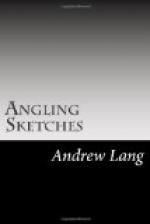I should have thought no more about him had I not twice afterwards seen him at a distance, fishing up a “lane” ahead of me, in the loneliest regions, and thereby, of course, spoiling my sport. I knew him by his peculiar stoop, which seemed not unfamiliar to me, and by his hat, which was of the clerical pattern once known, perhaps still known, as “a Bible-reader’s”—a low, soft, slouched black felt. The second time that I found him thus anticipating me, I left off fishing and walked rather briskly towards him, to satisfy my curiosity, and ask the usual questions, “What sport?” and “What flies?” But as soon as he observed me coming he strode off across the heather. Uncourteous as it seems, I felt so inquisitive that I followed him. But he walked so rapidly, and was so manifestly anxious to shake me off, that I gave up the pursuit. Even if he were a poacher whose conscience smote him for using salmon-roe, I was not “my brother’s keeper,” nor anybody’s keeper. He might “otter” the loch, but how could I prevent him?
It was no affair of mine, and yet—where had I seen him before? His gait, his stoop, the carriage of his head, all seemed familiar—but a short-sighted man is accustomed to this kind of puzzle: he is always recognising the wrong person, when he does not fail to recognise the right one.
I am rather short-sighted, but science has its resources. Two or three days after my encounter with this very shy sportsman, I went again to Loch Nan. But this time I took with me a strong field-glass. As I neared the crest of the low heathery slope immediately above the loch, whence the water first comes into view, I lay down on the ground and crawled like a deer-stalker to the skyline.




